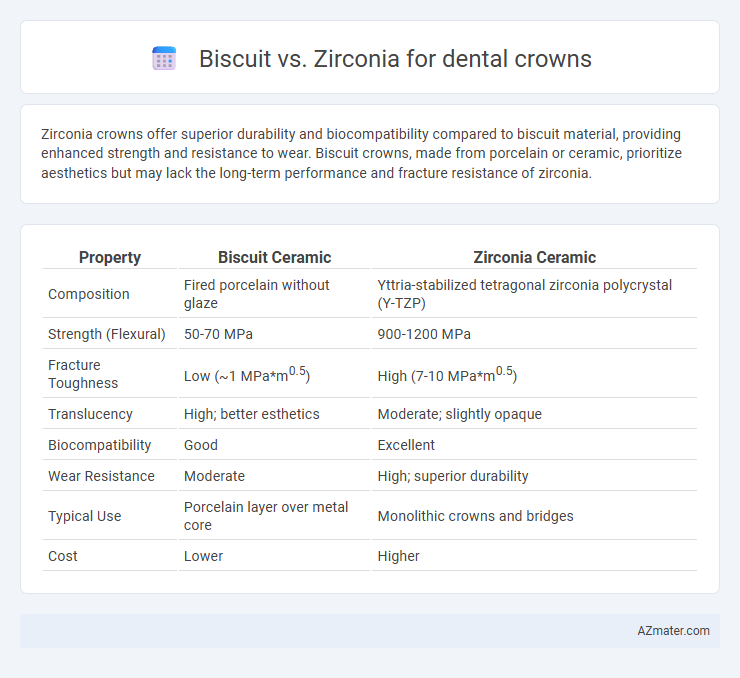Zirconia crowns offer superior durability and biocompatibility compared to biscuit material, providing enhanced strength and resistance to wear. Biscuit crowns, made from porcelain or ceramic, prioritize aesthetics but may lack the long-term performance and fracture resistance of zirconia.
Table of Comparison
| Property | Biscuit Ceramic | Zirconia Ceramic |
|---|---|---|
| Composition | Fired porcelain without glaze | Yttria-stabilized tetragonal zirconia polycrystal (Y-TZP) |
| Strength (Flexural) | 50-70 MPa | 900-1200 MPa |
| Fracture Toughness | Low (~1 MPa*m0.5) | High (7-10 MPa*m0.5) |
| Translucency | High; better esthetics | Moderate; slightly opaque |
| Biocompatibility | Good | Excellent |
| Wear Resistance | Moderate | High; superior durability |
| Typical Use | Porcelain layer over metal core | Monolithic crowns and bridges |
| Cost | Lower | Higher |
Introduction to Dental Crown Materials
Dental crown materials primarily include biscuit porcelain and zirconia, each offering distinct advantages for restorative dentistry. Biscuit porcelain provides excellent esthetics with its translucent, natural tooth-like appearance and is ideal for front teeth crowns. Zirconia crowns offer superior strength and durability, making them suitable for posterior teeth where high chewing forces are prevalent.
What is Biscuit in Dental Crowns?
Biscuit in dental crowns refers to the initial sintered state of ceramic materials, primarily used as an intermediate phase before final glazing and polishing. This stage allows dentists to assess fit and make necessary adjustments without compromising the crown's overall strength. Compared to zirconia crowns, which are known for their superior durability and esthetics, biscuit crowns offer easier customization but may require further processing to achieve optimal performance.
Understanding Zirconia Crowns
Zirconia crowns are renowned for their exceptional strength, biocompatibility, and natural tooth-like appearance, making them a preferred choice for dental restorations. Unlike biscuit crowns, which are primarily ceramic and more prone to chipping, zirconia crowns offer superior durability and resistance to fracture, suitable for both anterior and posterior teeth. Their translucency and ability to be precisely milled with CAD/CAM technology ensure a comfortable fit and aesthetic appeal that closely mimics natural enamel.
Strength and Durability Comparison
Zirconia dental crowns exhibit superior strength and durability compared to biscuit (porcelain) crowns, with compressive strength often exceeding 1200 MPa, making them highly resistant to fracture and wear. Biscuit crowns, primarily made from porcelain, offer aesthetic benefits but are more prone to chipping and fractures due to their lower tensile strength, typically around 400 MPa. The high fracture toughness and resilience of zirconia crowns ensure longer-lasting dental restorations, especially in high-stress areas like molars.
Aesthetic Differences: Biscuit vs Zirconia
Biscuit crowns offer superior translucency and natural tooth-like color, closely mimicking enamel, making them ideal for highly aesthetic zones. Zirconia crowns, while extremely durable and biocompatible, tend to have a more opaque appearance and less natural translucency compared to biscuit, which may affect the lifelike aesthetics in the anterior region. The choice between biscuit and zirconia crowns depends largely on the balance between desired aesthetics and functional strength in dental restorations.
Biocompatibility and Patient Safety
Zirconia crowns offer superior biocompatibility compared to biscuit crowns, reducing the risk of allergic reactions and inflammation in dental patients. Zirconia's inert ceramic properties minimize bacterial adhesion and promote gum tissue health, enhancing long-term patient safety. Biscuit crowns, often composed of less durable materials, may cause irritation or allergic responses, making zirconia the preferred option for dental restorations requiring optimal biocompatibility and safety.
Preparation and Fitting Processes
Biscuit crowns require a more extensive tooth reduction during preparation to accommodate the thicker, layered ceramic, ensuring proper fit and esthetics. Zirconia crowns benefit from minimal preparation due to their high strength and thinner profile, allowing for preservation of more natural tooth structure. Fitting zirconia crowns is generally faster because of precise CAD/CAM fabrication, while biscuit crowns might need more manual adjustments to achieve ideal seating and occlusion.
Longevity and Maintenance Considerations
Zirconia crowns are known for their exceptional durability and resistance to wear, making them a superior choice for long-term longevity compared to biscuit porcelain crowns. Maintenance for zirconia crowns is minimal due to their high fracture toughness and resistance to chipping, whereas biscuit crowns may require more frequent repairs or replacements due to their relative fragility. Patients seeking a lasting dental crown often prefer zirconia for its strength and low maintenance requirements.
Cost Comparison: Biscuit vs Zirconia
Biscuit dental crowns generally cost less than zirconia crowns, with prices ranging from $300 to $700 per crown compared to zirconia's $500 to $1,000 due to material and manufacturing differences. Biscuit crowns are made from porcelain fused to metal or ceramic blends, offering a budget-friendly option for patients prioritizing cost. Zirconia crowns, though higher in price, provide superior durability and aesthetics, which can reduce long-term replacement costs and offer better value over time.
Choosing the Right Crown Material for You
Choosing between biscuit and zirconia dental crowns depends on factors like durability, aesthetics, and biocompatibility. Zirconia crowns offer superior strength and longevity, making them ideal for back teeth subjected to heavy chewing forces, while biscuit crowns provide a more natural translucency suitable for front teeth. Consulting with a dental professional ensures the right crown material aligns with your specific oral health needs and cosmetic goals.

Infographic: Biscuit vs Zirconia for Dental crown
 azmater.com
azmater.com